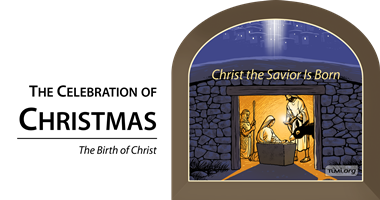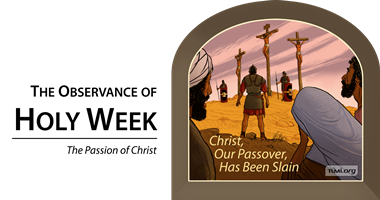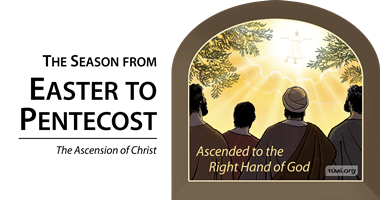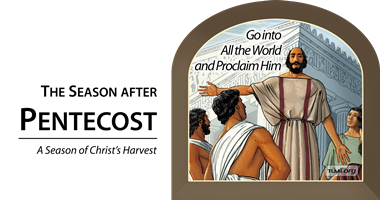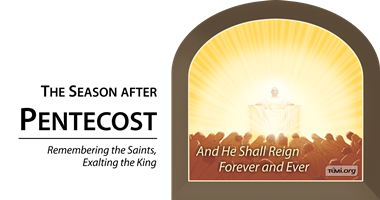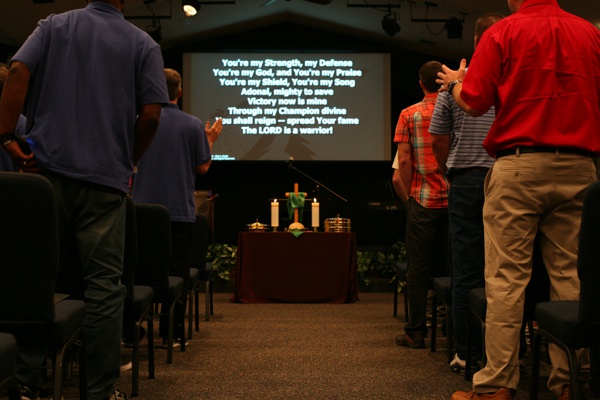 Remembering and Reflecting on Jesus, the Christ: Spiritual Formation through the Seasons of the Church Year
Remembering and Reflecting on Jesus, the Christ: Spiritual Formation through the Seasons of the Church Year
The Church Year begins with the birth of Christ (Advent to Epiphany). Next, it focuses on the revelation of his mission to the world (Epiphany and Transfiguration). It reminds us that Jesus set his face toward Jerusalem and the cross (Ash Wednesday and Lent). It chronicles his final week, his passion, his crucifixion (Holy Week), and his resurrection (the Resurrection of Christ). It affirms his Ascension to the Father’s right hand in glory (Ascension Day). It celebrates the birth of his Church through the ministry of his Spirit (Pentecost). It remembers the history of his Church throughout the ages (All Saints Day). Finally, it acknowledges that at his return, Christ will reign supreme as Lord and King over all (Reign of Christ the King). Advent both ends the cycle and begins it again. It looks forward to his Second Coming as the conclusion of the Church Year but also prepares to remember again his First Coming and thus starts the Church Year afresh.
Visit the full Season of Advent page.
Anticipation: 1st Week – The Advent wreath reminds us of God’s eternal love, without a beginning, without an end. The Candles reminds us of Christ’s light coming into the world. We light the first candle looking forward to the coming of the Messiah, Emmanuel, God-with-us.A season of anticipation and repentance which focuses on the First and Second Comings of Christ. The dual focus means that Advent both begins and ends the Christian year, (Is. 9:1-7, 11:1-16; Mk. 1:1-8).
Advent anticipates the First and Second Comings of our Lord. God's prophets foretold his Coming, and angels announced his birth to Mary and the shepherds. We affirm God's promise fulfilled in the arrival of Messiah in Bethlehem.
Annunciation: 2nd Week – We light the second candle to announce the birth of the Savior King, as the angel Gabriel announced to Mary, and the angels announced to the shepherds.
Affirmation: 3rd Week – We light the third candle recognizing the fulfillment of God’s promise of our salvation.
Arrival: 4th Week – We light the fourth candle in celebration of the arrival of the baby, born in a stable at Bethlehem, whose name is Immanuel, God-with-us.
Visit the full Celebration of Christmas page
A celebration of the mystery of the incarnation of the Son of God, the Word made flesh in the world. It celebrates the birth of Christ. (Lk. 2:1-20).
Christmas celebrates the mystery of the incarnation of the Son of God, the Word made flesh. He enters the world to reveal the Father’s love to humankind, to destroy the devil's work, and to redeem his people from their sins.
At Christmas, believers worldwide celebrate the birth of the Messiah in Bethlehem, the Lord Jesus Christ. Together we affirm that Jesus was--and is--God's only begotten Son, the Word made flesh, and the human son of the Virgin Mary. In him we see the love of God revealed for all humankind. He is God’s mystery that causes broken hearts to marvel and rejoice. This little child would fulfill the prophecy of a Savior who, by dying and rising, would conquer humanity's mortal enemy, the devil, free us from sin’s bondage and curse, and restore creation under the reign of God. "Joy to the world, the Lord has come! Let earth receive her King!"
Visit the full Season After Epiphany page
The Feast of Epiphany on January 6 commemorates the coming of the Magi which reveals Christ’s mission to the world. The entire season of Epiphany then emphasizes the way in which Christ revealed himself to the world as the Son of God, (Lk. 2:32; Mt. 17:1-6; Jn. 12:32).Epiphany commemorates the coming of the Magi, who followed the star in search of the Christ child. The season emphasizes Christ’s mission to and for the world. The light of God’s salvation is revealed to all peoples in the person of Jesus, the Son of God.
The Baptism of the Lord: The commemoration of Baptism of the Lord celebrates and remembers Jesus’ baptism by John the Baptizer at the beginning of his public ministry. Jesus’ true identity as Messiah and Lord was revealed by the Holy Spirit’s descent upon him in the form of a dove, and the Father’s testimony concerning him, “This is my beloved Son, with whom I am well pleased,” (Matt. 3.17).
Transfiguration Sunday: “Recalls the Transfiguration of Christ on the last Sunday of Epiphany (which is the Sunday before Ash Wednesday, the beginning of our lenten journey).” Robert Webber. The glory of Christ manifest in this world – to us and through us.
Visit the full Season of Lent page
Ash Wednesday: A day of fasting and repentance that reminds us that we are disciples about to begin the journey with Jesus that ends in the cross (Lk. 9:51). Ash Wednesday begins the observance of Lent.
Lent: A time for reflection on the suffering and death of Jesus. Lent also emphasizes “death to self” so that, like Jesus, we prepare ourselves to obey God no matter what sacrifice it involves. Lenten observance calls for people to fast as a way of affirming this attitude of obedience (Lk. 5:35; 1 Cor. 9:27; 2 Tim. 2:4; Heb. 11:1-3).The Lenten season, a forty-day period starting on Ash Wednesday and ending on Saturday of Holy Week (Holy Saturday), calls us to reflect on Jesus’ suffering, crucifixion, and death. Following our Lord, let us prepare ourselves on the way of the Cross for full obedience to God.
Visit the full Observance of Holy Week page
“In the ancient church the three days [of the Paschal Triduum] started on Thursday evening and ended with the great Paschal vigil of Saturday night. These services are called the Paschal Triduum [or, the Three Great Days] ... They are the most holy, solemn, and serious days of the entire year. For in these days we experience and encounter our own destiny in the destiny of Christ ignominious death and burial and in his triumphant resurrection from the dead.” Robert Webber, Ancient Future Time. Grand Rapids: Baker Books, 2004, p. 125. Holy Week recalls the events of Christ's suffering and death. We recall his triumphant entry into Jerusalem on Palm Sunday, his giving of the commandments on Maundy Thursday, his crucifixion on Good Friday, and the end the week with the solemn vigil of Saturday night (Holy Saturday) before Easter Sunday.
Palm Sunday: The Sunday before Easter which commemorates the Triumphal Entry of Christ (Jn. 12:12-18).
Maundy Thursday: The Thursday before Easter which commemorates the giving of the New Commandment and the Lord’s Supper prior to Christ’s Death (Mk. 14:12-26; John 13). [From the Latin mandatum novarum which means “new commandment” (John 13:34)]
Good Friday: The Friday before Easter which commemorates the crucifixion of Christ (John 18-19). [Listen to Dr. Davis teach our Good Friday service, and ponder the wonder of God's love displayed on the Cross for our salvation.]
Holy Saturday: The day before Easter which commemorates the burial of Jesus before his resurrection on Sunday (John 18-19).
Again, Holy Week is Lent’s final week. As a season, Lent starts on Ash Wednesday and ends Saturday of Holy Week, with a vigil on Holy Saturday. In the ancient church, new converts used Lent’s entire period to pray, fast, and repent as intense preparation for baptism on Easter morning. Today, we walk the way of the Cross with Jesus, reflecting on his lowliness and humiliation. The services of Thursday, Friday, and Saturday (called the Paschal Triduum) represent the most solemn days of the Church year. Here we clearly see the meaning of our baptism in Christ–being united with him in his suffering, death, burial, and resurrection from the dead.
Visit the full Season from Easter to Pentecost: The Resurrection of Christ page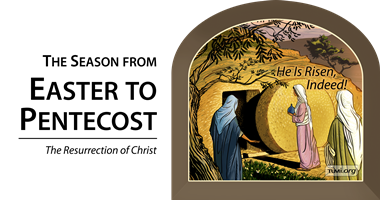
The Sunday which celebrates the resurrection of Christ (John 20).
On Easter Sunday we celebrate the resurrection of Jesus. He who was betrayed by his own disciple, crucified on a Roman Cross, and buried in a borrowed tomb, rose triumphantly from death to life through the power of God. “Christ is risen! He is risen, indeed!”
The exclamation “Christ is risen! He is risen, indeed!” is as old as the Church itself. It testifies to the central, controlling belief of believers in Jesus of Nazareth worldwide as they celebrate his victory over the grave in his bodily resurrection from the dead. As was prophesied in Scripture, and foreseen by our Lord himself, he suffered on the Tree bearing our sins in his body and overcoming the guilt and power of the grave and the curse. Yet, on the third day down he rose triumphant from the grave, and is alive now forevermore! His resurrection serves as the pinnacle of all Christian belief, and is itself the ground for all biblical revelation on the redemption won to us through the Father’s love.
Visit the full The Season from Easter to Pentecost: The Ascension of Christ page
The Ascension of Christ celebrates the Ascension of Christ to heaven at which time God “seated him at his right hand in the heavenly realms, far above all rule and authority, power and dominion, and every title that can be given, not only in the present age but also in the one to come” (Eph. 1:20b-21; 1 Pe. 3:22; Lk. 24:17-53).
The Ascension of Christ to heaven refers to that event where the risen Jesus, after 40 days of confirming his resurrection to his disciples, ascended to the Father. On his arrival, God “seated him at his right hand in the heavenly realms, far above all rule and authority, power and dominion, and every title that can be given, not only in the present age but also in the one to come” (Eph. 1:20b-21; 1 Pe. 3:22; Lk. 24:17-53). Here we celebrate with Christians all over the world the Ascension of our Lord to God’s right hand. Glorified by the Father as Head of the Church (cf. Eph. 1.15-23), our Lord has sent his Spirit into the world, intercedes for his own before God, and reigns above in a position of glory and power awaiting the coming judgment.
The Day of Pentecost: Pentecost is the day which commemorates the coming of the Holy Spirit to the church. Jesus is now present with all His people.
The Season after Pentecost is called Ordinary Time or Kingdomtide. During this time the Church considers the overarching theme of salvation history, the need for diligence in Christian discipleship, and focuses on the advance of the Kingdom to the ends of the earth. This is the longest season in the Church’s calendar, having from twenty-three to twenty-eight Sundays, and lasting until Advent. During this time we, as believers and congregations, focus on the Church’s maturity and multiplication and emphasize Christ’s headship and the power of the Holy Spirit in the ministry of the apostles and through the body of Christ.
The phrase Ordinary Time ought not to be interpreted as “unimportant time.” Rather, it should be understood in the sense of “counted or numbered days,” i.e., like “ordinal”numbers – fi rst, second, third. This has to do with the numbered Sundays of the year outside of the special seasons in the two cycles. These “ordinary” Sundays tend to emphasize Jesus’ earthly life and ministry (in the fi rst group of Ordinary Time between Epiphany and Lent), and his headship, harvest, and vigilance in light of Christ as our hope, and our remembering the saints through the ages and looking forward to the Reign of Christ. (in the larger group of Sundays in the second).
Visit the full Season After Pentecost (Kingdomtide): The Coming of the Holy Spirit page
The Season after Pentecost emphasizes the most significant sign of the Kingdom's presence in this world: the coming of the Holy Spirit. As Peter recounted in his sermon so many years ago, God had promised that in the last time the Spirit of God would be poured out on humankind, with all of the people of God prophesying, seeing visions, and dreaming dreams, both male and female. God's wonders would be seen in the earth, and the witness to God's salvation in Christ would be taken to the ends of the earth. Glory to God, we live in that age, the time of the presence of the heavenly dove and entrance of the Spirit into our world!Jesus is now present with his people in the person of the Spirit, to the glory of God the Father.
We ponder this mystery together on Trinity Sunday.
Trinity Sunday falls on first Sunday after Pentecost. At Pentecost Jesus is declared to be both Messiah and Lord (Acts 2:36) of course that is the day of the coming of the Holy Spirit. The Church has always been committed to a Triune understanding of God and this allows Christians to worship and ponder that mystery.
Visit the full Season After Pentecost (Kingdomtide): A Season of Christ's Headship page
During "ordinary time" (Kingdomtide), we consider God's saving acts through time. As Christus Victor, Jesus must reign until his enemies are put under his feet. He is the head of the body, the Church, and now he empowers his people to bear witness of his saving grace in the world.The Season after Pentecost is a season of recognition and affirmation of the headship and lordship of Jesus Christ.
According to the apostle Paul in his letter to Ephesians, God the Father has displayed his immeasurable power to the world in raising his Son Jesus Christ from the dead. The same Jesus who was humiliated and abused in a sham Roman trial and Jewish Sanhedrin council proceeding has now been vindicated. Through his death and resurrection, Jesus the Nazarene has proven himself to be the one, true Son of God, the Christ and Lord of all.
Visit the full Season After Pentecost (Kingdomtide): A Season of Christ's Harvest page
During the Season after Pentecost we engage in mission to the world. The risen and exalted Christ has given his people the commission to make disciples of all nations, to spread the Gospel of salvation to the ends of the earth.
In Matthew 9.37-38 Jesus said to his disciples, "The harvest is plentiful, but the workers are few. Therefore beseech the Lord of the harvest to send out workers into His harvest." He exhorted them to lift up their eyes and simply look of the fields of harvest, the teeming millions of the nations who need to know of God's grace in the Son of God. The harvest is ripe, and the fields are white; the peoples of the world are truly ready for harvest (John 4.34-35).As Lord of the harvest, Jesus has commissioned the Church to go and make disciples of all nations. During this season let us consider how we may advance God’s Reign as we show and tell of Christ's salvation to the world. This is a season of harvest.

Vist the full Season After Pentecost (Kingdomtide): A Season of the Hope of Christ's soon return page
As the dawn follows night, so our Lord will surely appear in power and glory to gather his own to himself, to make an end of war and sin, and to restore creation under God’s will.
This is a season of the hope of Christ’s soon return.The rhythms of time, of all time, will consummate with the coming of Jesus Christ at his return. Christians throughout the ages have yearned for the time when God will consummate his plan of salvation with the revelation of his Son at the end of this age. The darkness and shadow of this tragic human story, the Fall's dread and ugly curse, the costly punishment for our original foreparent's and our own will disobedience--death, will finally be overcome. The glory of God is destined to fill all heaven and earth, and God's own dear warrior-Son will put all enemies of the Father under his feet. This is our hope and our future!
Visit the full Season After Pentecost (Kingdomtide): Remembering the Saints, Exalting the King page
Reformation Day is the Christian festival day celebrated on October 31 to mark the Reformation, and is observed largely by Protestant mainline churches, and in particular, by both Lutheran and some Reformed churches.
All Saints Day is a time to remember those heroes of the faith who have come before us (especially those who died for the gospel). The living Christ is now seen in the world through the words and deeds of his people (Jn. 14:12; Heb. 11; Rev. 17:6).
Feast of Christ the King is the last Sunday before Advent – (also called the Feast of reign of Christ), important segue into advent, instituted in 1925 to function in counter cultural way against the secularization of the modern world.The Season After Pentecost (Kingdomtide), All Saints Day and The Reign of Christ the King: According to Scripture, Christ will return and finish the work he began on the Cross, to judge the world and save his own. The Feast of Christ the King, the last Sunday before Advent, points to the day when Christ will reign supreme.

